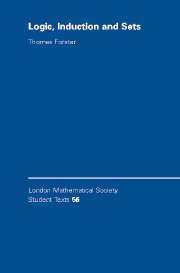7 - Ordinals
Published online by Cambridge University Press: 05 June 2012
Summary
The word ‘ordinal’ has been used for years to denote a kind of number word: there are ordinals and cardinals. Cardinals are words like ‘one’, ‘two’, ‘three’; ordinals are words like ‘first’, ‘second’, ‘third’. Although some of the original nature of the difference has been lost in the process of having these words appropriated by mathematics, a significant and important part remains: ordinal numbers allude to order, and to positions in a sequence. Happily, the best introduction to these ideas is by way of their historically first application.
For reasons we cannot go into here, Cantor was interested in the complexity of closed sets in ℜ. A closed set might be a perfect closed set (a union of closed intervals, so that every point is a limit point), or it might have some isolated points. If one removes the isolated points from a closed set, one might get a perfect set, but one might not. It might be that once one removes all the isolated points from a closed set, a point that had not been isolated before now becomes isolated. One measures the complexity of a closed set by the number of times one has to perform this operation of deleting isolated points to obtain a perfect closed set. The interesting feature is that, even if one performs this deletion infinitely often, one is not assured of obtaining a perfect closed set.
Information
- Type
- Chapter
- Information
- Logic, Induction and Sets , pp. 147 - 166Publisher: Cambridge University PressPrint publication year: 2003
